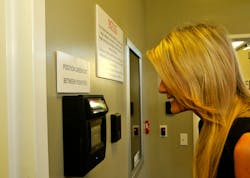Iris biometrics provide anonymity and security at U.S. Private Vaults
Anonymity and security are hallmarks of U.S. Private Vaults. Employees know virtually nothing about the customers accessing the private safe deposit boxes in the Beverly Hills, Calif. facility.
Renting a box requires no sharing of a name, address or social security number. Customers can pay their rental fees by cash or bitcoin to maintain total anonymity. The only set of box keys is kept by the customer. There is no concierge key commonly used at banks, allowing customers or their specified delegates to enter the vault and access their box without staff assistance.
The concept of anonymous, private vaults began over 25 years ago in Europe, where the number of these facilities are growing rapidly. U.S. Private Vaults opened its facility in 2012 in an upscale shopping area.
In addition to anonymity, USPV added layers of sophisticated security measures to protect customers’ property and identity. Officials at USPV quickly settled on iris recognition biometrics as its main method of identity authentication, said Matthew Bonvicin, the company’s chief technology officer.
“We were more or less set on iris identification from the beginning due to its ease of use, reliability, and speed,” he said. “We selected technology from Iris ID as it was top-rated in the all the research we did.”
Two Iris ID readers are in place. One is used for customer enrollment, the other for accessing the vault. New customers are enrolled when they rent a box. The customer may also register other users’ irises, allowing them to access the vault. More than 800 customers and USPV employees are currently enrolled in the system.
Enrollment takes only a few minutes. Once enrolled and given a short introduction on how to use the system, most customers are able to enter the vault door in a second or two.
The Iris ID software also integrates seamlessly with other USPV security systems. Iris scans are sent to a Brivo access control panel, which determines if the customer is authorized for vault entry. Proprietary Windows software uses the earliest box expiration data to delete access credentials. The entire process is duplicated with the hand geometry reader.
Bonvicin credited the Iris ID programming team with helping integrate the various systems into a single, easy-to-use interface. He said all systems and procedures have been designed for quick implementation as USPV plans expansion beyond its current location.
The iris, the colored part of the human eye surrounding the pupil, is like a snowflake – each one is unique. The Iris ID camera captures more than 240 unique characteristics to create a template of each customer’s iris. The resulting 512-byte templates are encrypted and can’t be reverse engineered or reconstituted to produce any sort of image or provide the person’s identity.
In addition to serving as an important security layer, the iris-based biometric system has also proven to be a valuable marketing tool, said Bonvincin.
“The system captures our potential customers’ imaginations,” he said. “Mentioning the words ‘biometric iris access’ drives home what we’re trying to do when explaining a private and anonymous safe deposit box facility. That continues as people become customers. They like that they’re part of something so high tech.”
The iris system is just part of the company’s dedication to security. The USPV vault is also equipped with motion detectors, heat sensors and other sophisticated security measures to detect after-hours intruders. The structural steel, reinforced concrete vault was designed to withstand natural disasters such as fires and earthquakes. The facility is also monitored 24 hours a day by a national security service.
For safety and legal reasons, USPV does prohibit the storage of some items — illegal drugs, weapons and ammunition, hazardous materials, illegal contraband and illegally obtained property. To ensure compliance, USPV uses drug and hazardous material detection dogs and other methods.
USPV takes its promise of anonymity seriously. The company urges customers to provide an attorney, beneficiary or custodian with information about the existence of the rented box or leave a letter with such information in the box in case of death or physical or mental incapacity.
Customers failing to pay their box rent are given a six-month grace period. If the customer can’t be contacted, a locksmith is called to open the box. Its contents will be stored in a private safe for three years. After that, USPV is required to forward all contents to the state of California. Otherwise, only a court order will force USPV to release the contents of the box to anyone but the renter.
Security and anonymity are words not often heard together. But the concept works at U.S. Private Vaults.
About the Author: Mohammed Murad is vice president, global development and sales for Cranbury, N.J.-based Iris ID, the world leader in iris recognition platform deployment. For more information visit www.irisid.com.



